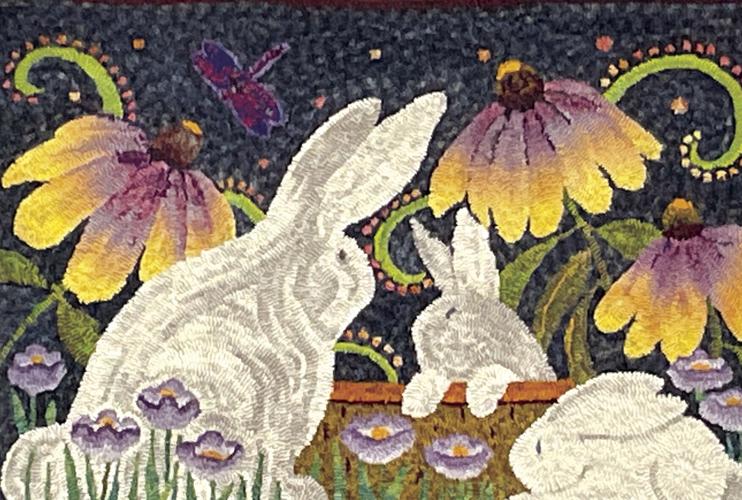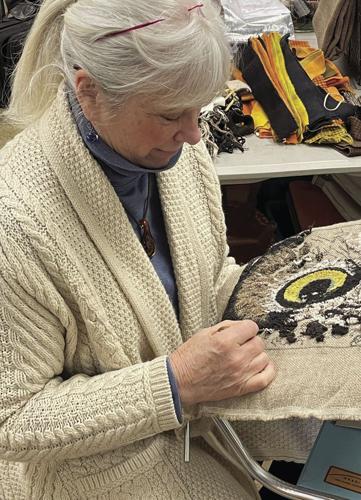LOUDON — All fiber is fun, says rug hooker Pam Bartlett. In Bartlett’s case, the fiber of choice is wool - soft wool in many colors from deep red to sky blue, lemon yellow, lush green and all the variations in between. Rug hooking is an old handcraft and today many people view it as an art form versus a craft.
Bartlett describes rug hooking in this way, “Historically, it involved one relatively simple technique of pulling either strips of wool fabric or yarns through a foundation cloth with a crochet-like hook in a handle. The most easily accessible foundation/backing was typically burlap bags. As rug hooking became mainstream, burlap was produced for the rug’s foundation. Over the decades, different foundation cloths have been developed and with the eventual demise of burlap production, other materials have emerged such as cotton, and a linen burlap-like material came about as an easier and more pleasant foundation.” Bartlett has worked with many materials and has been rug hooking since 1983.
As awareness of rug hooking grew in recent years, Bartlett’s abilities as a rug hooker grew as well. “I was always interested in fabric and ‘home’ crafts. That meant either sewing, quilting, needle work, painting and drawing and lots of traditional handicrafts most of my life. I bounced around from one to the other, until I landed on rug hooking.”
These days Bartlett runs a shop on Route 106 in Loudon called The Woolen Pear. Bartlett’s hooked rugs can be seen in the shop (as well as rugs made by her students and others). The rugs are skillfully done and invite the viewer into a world of color and textures. Bartlett’s rugs tell a visual story of many things and include such subjects as springtime bunnies in a multi-hued background to sailboats gliding on a lake, among a variety of other rugs.
What are the origins of the popular handicraft? Bartlett explains, “The history of rug hooking is as varied as the people that do it and depending on the materials available. Rug hooking does have a deep history in New England and the Maritimes of Canada. In New Hampshire, it was one of the founding crafts at the League of NH Craftsmen.”
Bartlett grew up in Concord, and first learned rug hooking with the late Hallie Hall of Contoocook. Hall was a respected rug hooking artist who taught and inspired many students. Bartlett learned how to rug hook and produce beautifully-crafted rugs and says the process of making a rug is really not as difficult as one may think.
As she honed her skills as a rug hooker, Bartlett started to consider giving classes to help others who wanted to pursue the unique art form. A class offers camaraderie and the support from a teacher who can give students the supplies and knowledge to begin rug hooking in the correct manner. While there are few set-in-stone rules in rug hooking, there are preferable ways to make a completed, attractive, and long-lasting rug, whether the rug will be used on a floor or hung, like a piece of art, on a wall.
Said Bartlett, when looking back on her early days as an instructor, “I started with a few students, then progressed to Adult Education classes at Concord and Laconia High Schools and at the League of NH Craftsmen’s Meredith shop. I do offer classes, plus on occasion I bring in another teacher with a different style and a following. This gives me and others the opportunity to take a workshop. This year I am booked to teach in Canada, Michigan and Ohio. I also organize a rug hooking retreat on Star Island in the Isle of Shoals off the New Hampshire coast and I am the director of a rug school that is held in the Lakes Region in the fall.”
Opening her shop was a big move, but she needed the space for teaching and selling wool and other supplies. With few such shops in the area, probably because rug hooking is a specialized pastime, there was certainly a hole to be filled in the market.
“I opened the shop in 2014 as I had run out of room in my studio. Opening one’s own business is often the dream of many creative or entrepreneurial people and it was something I had dreamed about, but never thought I would find the opportunity.”
She continued, “But women can be great supporters and enthusiastic at encouraging each other when it comes to creativity. I had some very inspirational rug hooking friends that had taken the plunge and I thought ‘if not now... when?’”
Since its long-ago beginnings, interest in rug hooking has seen a recent resurgence in popularity. The old-time craft has been reborn because modern supplies and the internet offer many new possibilities. Younger people are finding and becoming interested in learning rug hooking as well.
Some rug hookers purchase and hook a pattern on linen done by another and some see the craft as a pure art form, drawing their own patterns to express themselves. “I design my own patterns, but do not turn my nose up at another designer’s work if I find it interesting. I feel it is important to support other women business owners and designers, as the majority of rug hookers are women. I have always been attracted to beautiful, fine fabric and over the years I think I have acquired a pretty good eye for different wools, their quality and how they would hook up,” Bartlett said.
She continued, “Rug hooking, like quilting, seems to survive the test of time. It is always evolving, and it never really grows old or out of favor. I love that anyone can do it, no matter what they may think and often if they don’t think about it too much, they have a great time.
“Rug hooking has many aspects to it, and anyone with any amount of creativity can do it to their skill level and feel quite accomplished. There are so many sides to rug hooking, like drawing, working with colors and using a variety of materials.”
One of the important things Bartlett has learned and advises her students is, “It’s all about relaxing. In a beginner course of five to six weeks, students usually get the hang of it by the third class. That said, there are so many aspects of rug hooking and depending on one’s interest and what they want to learn it can take years like any craft to find their way in learning styles and color study.”
Somewhere in between a beginner and a highly-skilled rug hooking artist is the comfortable place most rug hookers settle. Many want to do rug hooking as a pastime to fill long winter evenings.
As for Bartlett, who has increased awareness of the old-time art form in today’s modern world, the future is wide open. “I am enjoying what I do and looking forward to whatever reveals itself. Also, I am exploring new ways to bring creativity to my rug hooking, to my students and to my clients.”
For Pam Bartlett, fiber is indeed a lot of fun.
(Pam Bartlett is a certified rug hooking teacher through Pearl K. McGown rug hooking teacher’s workshops, a juried member of the League of NH Craftsmen, a Master Artist with the New Hampshire State Council on the Arts and a six-time recipient of the Master Artist/Apprenticeship Grant program and a member of the Association of Traditional Hooking Artists. Visit www.redhorserugs.com, or find her on Facebook - Red Horse Rugs.)




















(0) comments
Welcome to the discussion.
Log In
Keep it Clean. Please avoid obscene, vulgar, lewd, racist or sexually-oriented language.
PLEASE TURN OFF YOUR CAPS LOCK.
Don't Threaten. Threats of harming another person will not be tolerated.
Be Truthful. Don't knowingly lie about anyone or anything.
Be Nice. No racism, sexism or any sort of -ism that is degrading to another person.
Be Proactive. Use the 'Report' link on each comment to let us know of abusive posts.
Share with Us. We'd love to hear eyewitness accounts, the history behind an article.